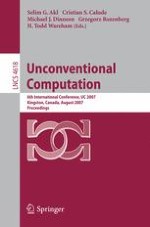2007 | Buch
Unconventional Computation
6th International Conference, UC 2007, Kingston, Canada, August 13-17, 2007. Proceedings
herausgegeben von: Selim G. Akl, Cristian S. Calude, Michael J. Dinneen, Grzegorz Rozenberg, H. Todd Wareham
Verlag: Springer Berlin Heidelberg
Buchreihe : Lecture Notes in Computer Science
